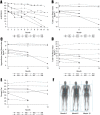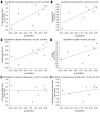Fat mass loss correlates with faster disease progression in amyotrophic lateral sclerosis patients: Exploring the utility of dual-energy x-ray absorptiometry in a prospective study
- PMID: 33956876
- PMCID: PMC8101939
- DOI: 10.1371/journal.pone.0251087
Fat mass loss correlates with faster disease progression in amyotrophic lateral sclerosis patients: Exploring the utility of dual-energy x-ray absorptiometry in a prospective study
Abstract
Background/objective: Weight loss is a predictor of shorter survival in amyotrophic lateral sclerosis (ALS). We performed serial measures of body composition using Dual-energy X-ray Absorptiometry (DEXA) in ALS patients to explore its utility as a biomarker of disease progression.
Methods: DEXA data were obtained from participants with ALS (enrollment, at 6- and 12- months follow ups) and Parkinson's disease (enrollment and at 4-month follow up) as a comparator group. Body mass index, total lean mass index, appendicular lean mass index, total fat mass index, and percentage body fat at enrollment were compared between the ALS and PD cohorts and age-matched normative data obtained from the National Health and Nutrition Examination Survey database. Estimated monthly changes of body composition measures in the ALS cohort were compared to those of the PD cohort and were correlated with disease progression measured by the Revised Amyotrophic Lateral Sclerosis Functional Rating Scale (ALSFRS-R).
Results: The ALS cohort (N = 20) had lower baseline total and appendicular lean mass indices compared to the PD cohort (N = 20) and general population. Loss in total and appendicular lean masses were found to be significantly associated with follow-up time. Low baseline percentage body fat (r = 0.72, p = 0.04), loss of percentage body fat (r = 0.81, p = 0.01), and total fat mass index (r = 0.73, p = 0.04) during follow up correlated significantly with monthly decline of ALSFRS-R scores in ALS cohort who had 2 or more follow-ups (N = 8).
Conclusion: Measurement of body composition with DEXA might serve as a biomarker for rapid disease progression in ALS.
Conflict of interest statement
The authors have declared that no competing interests exist.
Figures



Similar articles
-
Body composition in amyotrophic lateral sclerosis subjects and its effect on disease progression and survival.Am J Clin Nutr. 2022 May 1;115(5):1378-1392. doi: 10.1093/ajcn/nqac016. Am J Clin Nutr. 2022. PMID: 35108352 Free PMC article.
-
Individuals with amyotrophic lateral sclerosis are in caloric balance despite losses in mass.J Neurol Sci. 1995 May;129 Suppl:47-9. doi: 10.1016/0022-510x(95)00061-6. J Neurol Sci. 1995. PMID: 7595619 Clinical Trial.
-
Association between nutritional status and disease severity using the amyotrophic lateral sclerosis (ALS) functional rating scale in ALS patients.Nutrition. 2015 Nov-Dec;31(11-12):1362-7. doi: 10.1016/j.nut.2015.05.025. Epub 2015 Jul 6. Nutrition. 2015. PMID: 26429656
-
Visceral adiposity and inflammatory bowel disease.Int J Colorectal Dis. 2021 Nov;36(11):2305-2319. doi: 10.1007/s00384-021-03968-w. Epub 2021 Jun 9. Int J Colorectal Dis. 2021. PMID: 34104989 Review.
-
Nutrition management methods effective in increasing weight, survival time and functional status in ALS patients: a systematic review.Amyotroph Lateral Scler Frontotemporal Degener. 2018 Feb;19(1-2):7-11. doi: 10.1080/21678421.2017.1360355. Epub 2017 Aug 11. Amyotroph Lateral Scler Frontotemporal Degener. 2018. PMID: 28799809
Cited by
-
Interaction of sex and onset site on the disease trajectory of amyotrophic lateral sclerosis.J Neurol. 2023 Dec;270(12):5903-5912. doi: 10.1007/s00415-023-11932-7. Epub 2023 Aug 24. J Neurol. 2023. PMID: 37615751
-
The myokine FGF21 associates with enhanced survival in ALS and mitigates stress-induced cytotoxicity.bioRxiv [Preprint]. 2024 Sep 14:2024.09.11.611693. doi: 10.1101/2024.09.11.611693. bioRxiv. 2024. PMID: 39314333 Free PMC article. Preprint.
-
Rapid progression of amyotrophic lateral sclerosis after initiation of GLP-1 agonist: a case report.Amyotroph Lateral Scler Frontotemporal Degener. 2025 May;26(3-4):382-384. doi: 10.1080/21678421.2024.2446847. Epub 2025 Jan 7. Amyotroph Lateral Scler Frontotemporal Degener. 2025. PMID: 39772789 No abstract available.
-
Nutritional and metabolic factors in amyotrophic lateral sclerosis.Nat Rev Neurol. 2023 Sep;19(9):511-524. doi: 10.1038/s41582-023-00845-8. Epub 2023 Jul 27. Nat Rev Neurol. 2023. PMID: 37500993 Review.
-
Use of Muscle Ultrasonography in Morphofunctional Assessment of Amyotrophic Lateral Sclerosis (ALS).Nutrients. 2024 Mar 31;16(7):1021. doi: 10.3390/nu16071021. Nutrients. 2024. PMID: 38613054 Free PMC article.
References
Publication types
MeSH terms
Substances
Grants and funding
LinkOut - more resources
Full Text Sources
Other Literature Sources
Medical
Miscellaneous

